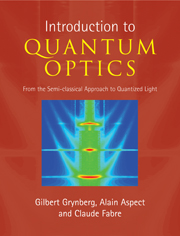Book contents
- Frontmatter
- Contents
- Foreword
- Preface
- Acknowledgements
- Part I Semi-classical description of matterlight interaction
- 1 The evolution of interacting quantum systems
- Complement 1A: A continuum of variable width
- Complement 1B: Transition induced by a random broadband perturbation
- 2 The semi-classical approach: atoms interacting with a classical electromagnetic field
- Complement 2A: Classical model of the atom-field interaction: the Lorentz model
- Complement 2B: Selection rules for electric dipole transitions. Applications to resonance fluorescence and optical pumping
- Complement 2C: The density matrix and the optical Bloch equations
- Complement 2D: Manipulation of atomic coherences
- Complement 2E: The photoelectric effect
- 3 Principles of lasers
- Complement 3A: The resonant Fabry–Perot cavity
- Complement 3B: The transverse modes of a laser: Gaussian beams
- Complement 3C: Laser light and incoherent light: energy density and number of photons per mode
- Complement 3D: The spectral width of a laser: the Schawlow–Townes limit
- Complement 3E: The laser as energy source
- Complement 3F: The laser as source of coherent light
- Complement 3G: Nonlinear spectroscopy
- Part II Quantum description of light and its interaction with matter
- Part III Applying both approaches
- Index
Complement 2A: Classical model of the atom-field interaction: the Lorentz model
Published online by Cambridge University Press: 05 August 2012
- Frontmatter
- Contents
- Foreword
- Preface
- Acknowledgements
- Part I Semi-classical description of matterlight interaction
- 1 The evolution of interacting quantum systems
- Complement 1A: A continuum of variable width
- Complement 1B: Transition induced by a random broadband perturbation
- 2 The semi-classical approach: atoms interacting with a classical electromagnetic field
- Complement 2A: Classical model of the atom-field interaction: the Lorentz model
- Complement 2B: Selection rules for electric dipole transitions. Applications to resonance fluorescence and optical pumping
- Complement 2C: The density matrix and the optical Bloch equations
- Complement 2D: Manipulation of atomic coherences
- Complement 2E: The photoelectric effect
- 3 Principles of lasers
- Complement 3A: The resonant Fabry–Perot cavity
- Complement 3B: The transverse modes of a laser: Gaussian beams
- Complement 3C: Laser light and incoherent light: energy density and number of photons per mode
- Complement 3D: The spectral width of a laser: the Schawlow–Townes limit
- Complement 3E: The laser as energy source
- Complement 3F: The laser as source of coherent light
- Complement 3G: Nonlinear spectroscopy
- Part II Quantum description of light and its interaction with matter
- Part III Applying both approaches
- Index
Summary
This first complement is devoted to a completely classical approach of lightmatter interaction which was proposed by Lorentz at the end of the nineteenth century, before the advent of quantum mechanics, but after the discovery of the electron. Lorentz' phenomenological model is based on the experimental fact that atoms have well-defined and sharp absorption lines: he assumed that atoms behaved like harmonic oscillators, in which the electrons are bound to the atomic nucleus by a restoring force which varies linearly with its displacement (from its equilibrium point close to a nucleus), and makes them oscillate at a given frequency ω0 equal to the experimentally determined absorption frequency.
Within the frame of this model, we first calculate the electromagnetic field radiated by an oscillating electron. We show that in the absence of an externally applied force the free oscillations of the electron are damped, because electromagnetic energy is radiated at the expense of mechanical energy. We then study the characteristics of the radiation that is emitted when the oscillations are forced by the application of an external oscillatory electromagnetic field of angular frequency ω. We characterize the different regimes of this scattering of the incident electromagnetic wave and finally determine the polarization induced in the atomic medium by the incident electromagnetic wave.
The Lorentz model can be considered as a lowest order approximation to a description of the light–matter interaction, a better approximation being the semi-classical treatment presented in Chapter 2, and the rigorous treatment being the completely quantum mechanical model presented in Chapter 6.
- Type
- Chapter
- Information
- Introduction to Quantum OpticsFrom the Semi-classical Approach to Quantized Light, pp. 105 - 119Publisher: Cambridge University PressPrint publication year: 2010



